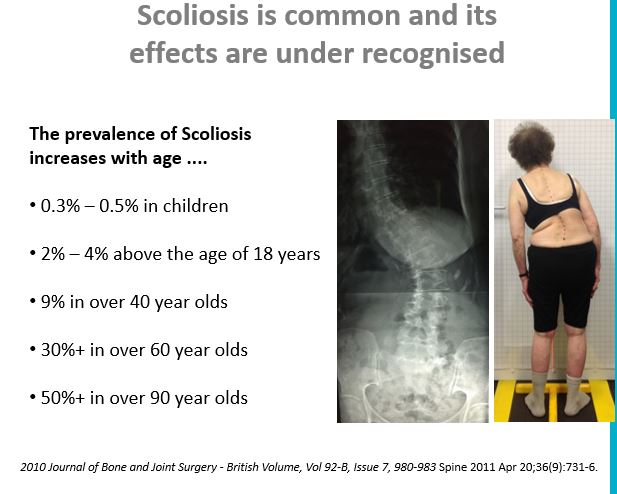It is a commonly held belief that once a person’s skeleton fully matures, and they are done growing, there is no cause for concern about scoliosis getting worse. This idea stems from an assumption that scoliosis, as a spinal deformity, is a stable and fixed quantity once maturity is reached. As a consequence of this assumption, even young adults who have just reached skeletal maturity are told that there is either nothing that can be done, or that there is no cause for concern about their scoliosis. Similarly, more mature adults are also quite often told that there is nothing to be worried about. The unfortunate truth is that scoliosis is actually a dynamic process that causes progressive spinal deformity over time. This is a very different assumption than is generally made. Unfortunately, making the wrong assumption about scoliosis can have significant health consequences for those who suffer with the condition.
Let’s examine some of the statistics on the incidence of scoliosis in the population. In children under the age of 18 the incidence of scoliosis ranges from 0.3% to 0.5% of the population. In people above the age of 18 the incidence increases to between 2% and 4%. The incidence of scoliosis in those over 40 is 9%, and in those over 60 it is over 30%. If you are lucky enough to live to be 90 years old, the incidence of scoliosis among your peers is 50% +. Obviously, if we see these types of trends in those who are skeletally mature, we must conclude that scoliosis progresses with age. In a 2017 article published in the Archives of Physical Medicine and Rehabilitation it was concluded that the mean rate of progression in adults with scoliosis was 1.28° per year, regardless of the cause of the scoliosis.

These facts have implications for how mature patients with scoliosis should be managed. Contrary to what is often concluded, when a child with scoliosis matures they should still be actively monitored and, if the curves are large enough, treated to, at the very least, prevent progression. It has been my experience that the goals of treatment can, and should be, more optimistic than just holding the curve in place. Oft times curves can be improved very significantly.
When it comes to mature and even older adults, it is all too common to see the consequences of scoliosis being neglected until such time as surgical intervention is necessary. Unfortunately, older adults typically experience significant chronic pain, postural deterioration and some degree of disability associated with scoliosis. The reason scoliosis worsens with age has to do largely with how the condition causes an acceleration of degeneration in the spine. Degeneration is almost always progressive and causes curves to worsen, can cause spinal instability, and can even predispose people to spinal fractures. All of these circumstances can be mitigated to some degree by being vigilant about, and attentive to, the needs of patients with scoliosis, even when they are older.
In older adults, though it is possible to see some improvement in scoliotic curves, the goals of treatment are generally to reduce pain, prevent progression of curves, create spinal stability, improve posture, and minimize any disability. These goals are accomplished by combining specific types of chiropractic care, physical rehabilitation exercises, and sometimes bracing. I have seen bracing make an almost astounding difference, even for scoliosis patients in their 70s and 80s. Bracing usually allows a person to stand more upright, improves breathing and cardiac function, reduces pain, and prevents patients from getting worse as they age. We recommend and utilize a particular bracing product called ScoliBrace which provides a true three-dimensional, super-corrective approach to scoliosis. The idea behind bracing, and all of the other modalities used to treat scoliosis, is to allow people to live long, pain-free, and productive lives. I think that one of the main points to be made is that if you are an adult with scoliosis, there is cause for vigilance, but also a cause for hope. You simply need to seek out those who can see the condition for what it actually is, and then explore and implement all available options for treatment.



